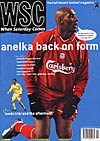 The Bowyer and Woodgate case cast a shadow over efforts by Leeds United to throw off their old racist image. Soheb Panja compares their progress with that of West Ham
The Bowyer and Woodgate case cast a shadow over efforts by Leeds United to throw off their old racist image. Soheb Panja compares their progress with that of West Ham
At Upton Park the flimsy Let’s Kick Racism Out Of Football sign is sandwiched by the pitch and the notorious Chicken Run, a small stretch at the corner of the East Lower Stand where it meets the Bobby Moore Stand. The most vitriolic abuse heard anywhere in the ground is aimed at petrified players wandering over to take corners (just ask David Beckham). From my comparatively placid vantage point in the West Stand, I always check who the unlucky left midfielder is on the opposing side. I think I can confidently say, however, that the abuse these days is always because of the colour of the player’s shirt and not the colour of his skin. I always think it is too much of a coincidence that the campaign’s sign should be placed where it is.
As the bananas are no longer raining on the pitch and the howls of monkey noises are rarely heard, racism in football is said to be on the wane. Recent publicity about racism at Millwall has been dismissed as “an exceptional case”. But I have yet to see a football stand anywhere with even the remotest similarity to the one projected by Sky television’s introduction to their live games: a carefree blonde girl sitting among a range of “non-white” people.
Having followed West Ham at home and away, and spent three years studying in Leeds, I feel I am in a position to make some first-hand judgments about the differences between the two. There is a bit of an edge that comes with West Ham’s away games. I have now become used to semi-threatening stares from heavily tattooed men. But the little open racism I’ve heard induces embarrassment rather than fear. It is certainly an awkward feeling when a section of the fans near me are singing “I’d rather be a Paki than a scouser” while I can feel the looks of disdain as well as sympathy directed towards me.
While in Leeds, I often went to Elland Road. Nowhere, in my experience of Premiership grounds, is there a more malevolent atmosphere. Last season, many Leeds fans seemed to take the lack of censure for Bowyer and Woodgate as a sign (and a welcome one) that the club was somehow racist. That all the players shaved their heads during their Champions League run-in didn’t help.
Leeds is a strange city demographically. Although other big cities have distinct “ethnic” areas, they are generally in close proximity to predominantly white areas. In Leeds, the working classes live in isolated settlements some distance from the city centre and the demarcation lines are very clear. One evening in Leeds a friend’s car broke down in a particularly white area. One boy in a Leeds shirt wandered over on his bike as we called the AA awaiting a new battery. He casually said to me: “I bet the AA man’s like you, a Paki.” He didn’t seem malicious but had just imbibed the culture and attitudes of his area.
On the few occasions when watching England play away I have felt conspicuously not English. At France 98 I was asked: “Why’s a fucking Paki got an England shirt on?” The questioner had a tattoo on his forearm that read “LUFC”. As the Bowyer/Woodgate trial dragged on I noticed the odd Asian face in the crowd at Elland Road. I can only imagine their sense of divided loyalty. I would hate to be in a situation where I feel alienated from West Ham because I’m Asian.
Ironically, Leeds and West Ham, two Premiership clubs with bad reputations for racism, are also the only two with Asians on their books. Both clubs recognise the need to tap into the local reservoir of support and talent. Community initiatives go some way to bridging the gulf between football culture and the reality of multicultural cities in Britain. However, there is still a huge disparity between the noises in the boardroom and the noises from the stands.
From WSC 180 February 2002. What was happening this month